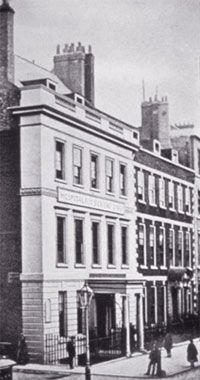A Marble Bust of Dr Richard Mead.
Physician in Ordinary to George II.
Doctor to Isaac Newton, Collector.
11 August 1673 - 16 February 1754.
by Louis Francois Roubiliac.
At the Royal College of Physicians.
Regents Park, London.
The bust was created at the expense of Dr. Anthony Askew, and
presented by him to the College in 1756, when displayed in the Physicians building in Warwick-Lane it was originally supported on a
bracket, which bore the following inscription:—
Hanc Richardi Meadii
effigiem, literarum atque artis medicae statoris et vindicii perpetui, amicitiæ
causa ponendam curavit Antonius Askew, M.D. 1756.
The photographs below were taken in the Censors Room at the Royal College of Physicians on 8 September 2016.
I am very grateful to staff at the Royal College of Physicians for their kind assistance.
Portrait of Richard Mead MD.
Arthur Pond.
Royal College of Physicians.
.....................................

Why has this image been removed???
A
meeting of the College of Physicians: This engraving was published as Plate 20
of Microcosm of London,
(1808).
Thomas
Rowlandson (1756–1827) and Augustus Charles Pugin (1762–1832).
At the old College in Warwick Lane.
Depicting the busts of Baldwin Hamey by Edward Pearce (above the door), and Dr William Harvey by Scheemakers in the Censors Room.
___________________________________________
For the Plaster busts at the British Museum purchased by Matthew Matey at the posthumous Roubiliac Sale including a bust of Richard Mead and for further portraits of Dr Mead see my blog entry -
For a brief summaries of his life and times see -
and
For his monument in Westminster Abbey (he was buried in the Temple Church) see -
The monument is by Scheemakers.
_______________________________
For an annotated Catalogue of the Collection of Richard Mead sold by Langford's of the Piazza Covent Garden Tuesday 11 March 1755 giving the price achieved and purchaser.
"A
catalogue of the genuine and entire collection of valuable gems, bronzes,
marble and other busts and antiquities, of the late Doctor Mead : which (by
order of the executors) will be sold by auction, by Mr. Langford, at his House
in the Great Piazza, Covent Garden, on Tuesday the 11th of this instant March
1755, and the four following days. The said collection will be exhibited to public
view on Friday, Saturday and Monday, the 7th, 8th and 10th instant, from ten in
the morning till four, and the sale will begin each day punctually at twelve
o'clock. Catalogues of which may be had on Thursday the 6th, at Mr. Langford's
aforesaid".
Lots on the first day included busts in white marble by Scheemaker
61. Shakespear bought Skinner.
62. Milton bought Duncomb.
63. Pope bought Gen' Campbell.
The Library of Dr Mead at Great Ormond Street.
_____________________________________________

49 Great Ormond Street,
Home of Richard Mead, previously occupied by physician Sir John Radcliffe.
The famous library was designed by James Gibbs and built 1732 - 34.
......................................











































